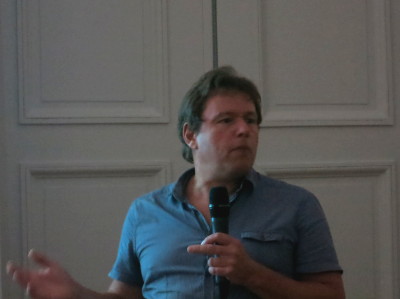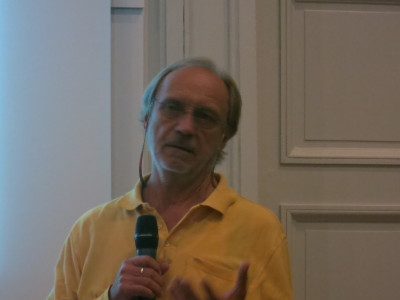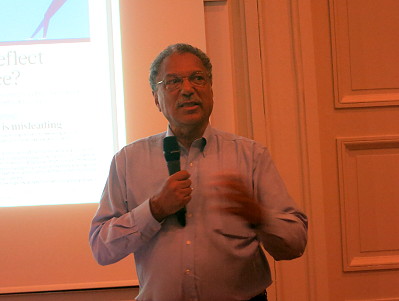 The annual meeting of the FishBase Consortium was again an opportunity to convene a public symposium with latest research advances. Hosted this year in the Muséum national d'Histoire naturelle in Paris, the symposium took place against the backdrop of the historical setting in the Amphithéâtre Rouelle surrounded by the famous Jardin des Plantes.
The annual meeting of the FishBase Consortium was again an opportunity to convene a public symposium with latest research advances. Hosted this year in the Muséum national d'Histoire naturelle in Paris, the symposium took place against the backdrop of the historical setting in the Amphithéâtre Rouelle surrounded by the famous Jardin des Plantes.
After the welcome of the President of the Museum, Bruno David, Nalani Schnell presented interesting glimpses of the weird and wonderful of the fish larvae collection. She outlined some new insights of which larvae belong to which adult fish. Often times, this is a very difficult task requiring the entire tool kit of investigation from morphological studies to DNA analysis, where possible, to rearing larvae to adulthood.
Patrice Pruvost, Consortium member and host of the meeting, spoke about an observatory of marine biodiversity in the southern ocean. He was followed by Paulo Brito of Brazil who suggested to introduce fossil fish species in still existing modern fish families as a way to improve phylogenetic and biogeographical understanding of today's fishes, among others. The consortium accepted this proposal unanimously.
 Rainer Froese of GEOMAR in Kiel, Germany, reported on his latest research about determining the intrinsic rate of population growth as a key element to advise on management and conservation. He had completed the assessment already for the first 1000 stocks.
Rainer Froese of GEOMAR in Kiel, Germany, reported on his latest research about determining the intrinsic rate of population growth as a key element to advise on management and conservation. He had completed the assessment already for the first 1000 stocks.
Once introduced into the webversion of FishBase, these parameters can be extremely valuable to assess the resilience of exploited populations.
Having the indicator available of a growing number of species is also important for rebuilding stock sizes so that they can produce maximum sustainable yield.
Cornelia E Nauen spoke about using FishBase to develop teaching materials about the functioning and changes of marine ecosystems in response to demands by artisanal fishers in Senegal.
Daniel Pauly presented the results of more than 10 years of painstaking work by more than 350 scientists in many parts of the world aiming at the reconstruction of marine catches by country and major island.
 The starting point was the incomplete reporting of marine catches by national governments to the Food and Agriculture Organization of the UN (FAO), the only organisation collating global production statistics.
The starting point was the incomplete reporting of marine catches by national governments to the Food and Agriculture Organization of the UN (FAO), the only organisation collating global production statistics.
Subsistence and recreational catches are often not accounted for at all though they can be substantial, both from the perspective of quantities and socio-economic roles. Indeed, most subsistence catches are made by women and play an important role in household food security. Even commercial artisanal catches are usually poorly covered even though their catches and landings continue to increase while industrial catches decrease sind 1996.
When adding discards at sea and illegal catches the difference between official statistics and the ground realities can easily be 50% or more. In the case of West Africa, only a quarter of the real catches enter the global statistics! The national statistics cover only half of the domestic extractions, but neither national nor global statistics reflect the discards and illegal catches by foreign fleets.
Thanks to these efforts some improvements are noticeable in some national and the global statistics, but it is necessary to do a lot more in order to improve the basis for political and economic decision making.
Click here for the full programme. Pictures by CE Nauen.














